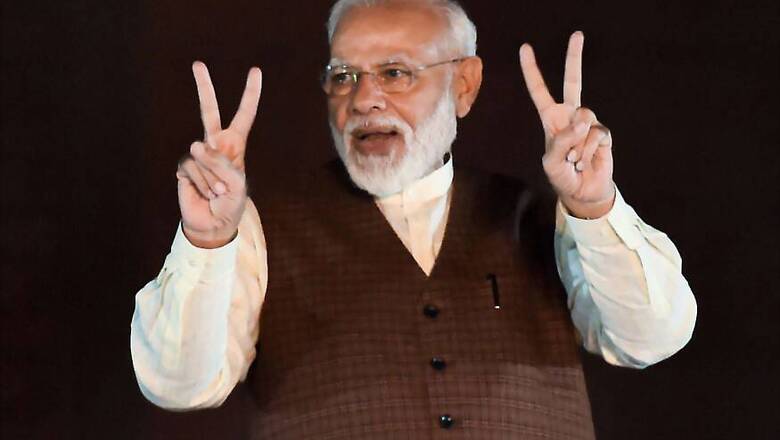
views
Is Prime Minister Narendra Modi a reformist? Where would he rank in the annals of Indian reformers? This question keeps getting regurgitated every once a while and there is reason for it. In the six years that Modi has now been in his office, his critics have been unable to pin him down on any substantial governance related critique. Modi is not corrupt, his government is scam-free, there are no charges of nepotism and the leftist slurs of anti-poor have also rung hollow as the 2019 elections proved. With no real sticking point, the ‘reform’ question keeps getting rehashed. So, what is the truth? Is Modi a reformer or not?
Any fair assessment of Modi’s first term would establish that “Modi is not a reformer’ label has no real legs to stand on. To give just two examples, consider this sentence from a December 2008 article in the Financial Express: “The UPAs biggest financial sector reform measure in its four-and-a-half year tenure, the Insurance Laws (Amendment) Bill, which seeks to hike the foreign direct investment limit in the sector to 49% from the existing 26%, was finally introduced in the Rajya Sabha.”; and this sentence from an August 2012 article in The Economic Times, “Economists and policymakers have been urging the government to deregulate diesel prices”.
Former Prime Minister Manmohan Singh was unable to get moving on these or any other real reform, for that matter, during his 10 years in office. Both of these were done early on in Modi’s first term itself. This alone should have settled the question on Modi’s reformist credentials. But consider just a few examples of what else was achieved in Modi’s first term – GST; IBC; transparent, rule based, auction of natural resources; RERA; Trading across borders reforms and the revolutionary establishment of the DBT regime.
Realising that it may no longer be sustainable to stick to the “where are the reforms” narrative, the critics later nuanced the question to “where are the big-bang reforms?” The trick, presumably, was that since no one defined what constituted a big-bang, the question could be asked endlessly. But the critics had not bargained for Modi 2.0. Even before the recent announcements following the ‘Aatm Nirbhar Bharat’ speech, a slew of big bang reforms such as the mega bank mergers, reforming myriad labour laws and merging them into four well defined labor codes and the lowering of corporate tax rates to among the lowest in the world had been announced and implemented. And then came the latest series of announcements in the month of May 2020.
In the agriculture sector, one can make the case that May 2020 for farmers is what August 1947 is for India. Our ‘annadata’ is finally ‘aatm nirbhar’. The Agricultural Produce Market Committee (APMC) is history. The Damocles sword of Essential Commodities Act has been blunted. After decades, our farmers have finally been freed. They can now produce what they want, sell wherever they want and at whatever price they can command. And the holy grail of agricultural reforms — Contract Farming — has also become a reality. This would mean industrial scale investment in agriculture, modern technology and integrated markets.
But the big-bang month of May is not just limited to agriculture. Commercial coal mining is now open. The millstone of only allowing captive coal mining is gone. The MSME sector has been unshackled. It can now grow without the limiting fear of outdated definitions. FDI in Defence through automatic route is now up to 74% (100% on case-to-case basis).The holy grail of PSU privatisation is finally a reality through a policy framework — in strategic sectors (a very short list) government entities would be limited to a maximum four and even there private players would be allowed; in non-strategic sectors government would completely exit. The space sector has been opened for private enterprise and ingenuity. One-nation-one-card is going to be a reality.
These reform measures and the quick legal frameworks created to support them have finally punctured the “where are the big-bang reforms?” narrative as well. So, a new line was invented by the perennial Modi critics. “Sure, Modi has good reform ideas, but his implementation track record is poor”. The problem with this latest formulation is that not even the worst opponents of Modi would agree.
Right from his days as the Gujarat Chief Minister to his six years in office as Prime Minister, if there is one USP of Modi, it is his implementation skills. From Jan Dhan bank accounts, to electricity in every village and almost every household, to Ujjwala to Pradhan Mantri Awas to Jan Suraksha to Ayushman Bharat to Mudra disbursements to sanitation to Mission Indradhanush — the reason why Modi won a second term with enhanced majority is because he delivered successfully by implementing almost every scheme he championed.
But the real, lasting legacy of Modi, beyond these concrete reform achievements of his government is his own personal contribution in two domains. First, it is Modi who established the politics of data-driven governance. It is he who, even when he was campaigning as far back as in 2013, introduced data and facts and comparative numbers in every day political lexicon, partisan political debates, including even in political rallies. One can see today that it has become an established political norm, across political parties, to differentiate own government’s achievements by listing out numbers and facts. Second, before Modi, the top economic leadership policy making almost exclusively confined itself to macro-economic policy. Micro-economics was like a discarded distant cousin. It is that mindset which led to just 38% sanitation coverage 65 years after independence, and just 58% bank accounts 45 years after bank nationalisation. One of Modi’s lasting contributions is the reversal of this attitude at the Prime Minister level. His focus on micro-economics, even while handsomely delivering on macro is what for example ensured that India is now producing almost 4.5 lakh PPE suits per day from zero just three months ago.
May 2019 buried the question whether Modi can implement policies or not. Modi 2020 has finally buried the “whether Modi is a reformer or not” question as well. Critics have a choice — either remain perennial Modi opponents just for the sake of it or become the solution providers as India looks to engage the post COVID-19 world in a new light.














Comments
0 comment